Planting brugmansia and caring for it in the open field
The brugmansia plant, which can be grown both in the open field and in a container, got its name in honor of Leiden University professor Sebald Justinus Brugmans. The genus belongs to the Solanaceae family, it includes 11 species of shrubs and dwarf trees, up to 3 m high. The popular name is "Angel pipes", "Moon flowers".
Differences between brugmansia and datura
The brugmansia flower, with a strong aroma, similar in shape to the trumpet of a gramophone, looks like a datura (dope), resulting in confusion. It is important to remember that both plants are poisonous, so growing them at home is undesirable. When working with these members of the nightshade family, use gloves and be careful not to allow animals and children to come into contact with them.
There are several differences between these plants:
- the root system of the brugmansia is fibrous, the datura has an underground rhizome;
- the flower of brugmansia is always directed downward, and in dope it is upward;
- brugmansia varieties are distinguished by a variety of shades, datura has only a few colors;
- brugmansia is a perennial with a semi-lignified trunk, datura in central Russia is a herbaceous annual;
- brugmansia grown from cuttings or seeds, with optimal care, blooms in the second year, and datura always blooms in the year of planting.
Angel Trumpets can be grown as a tub plant or outdoors, but they are dug up and stored in a cool room for the winter, such as in a basement or on a glazed balcony. This tree has an interesting feature: during the growing season, its leaves are symmetrical, and during the flowering period, asymmetric. This way you can determine when brugmansia will begin to bloom. The plant is native to the tropics, but tolerates a short-term drop in temperature to 0 ° C. At +7 ° C, it can shed some of the leaves, continuing to bloom.
Planting brugmansia in the ground
In the spring, when the tree wakes up after a dormant period, it needs to be taken out to a lighted area and watering resumed, but you should start with small doses. The care of the plant includes hardening, for which it is taken out daily to fresh air. If you plan to plant brugmansia in the ground, from April you can already feed the flower with ash or liquid fertilizers with a high nitrogen content.
Outdoor brugmansia care begins with finding a very bright area to place it. From May, when the threat of frost has passed, the trees are planted in a large container (at least 10 liters) filled with a nutritious substrate or directly into the soil, in a permanent place. It is undesirable to plant a tree in a peat-based composition: you need to add a lot of loamy soil and humus to the mixture.
It is better to spill the substrate in advance with a pink solution of potassium permanganate and dry it to a loose, slightly damp state. The more nutritious the earth is, the better. Since the root system of the "Angel pipes" develops very quickly, the plant growing in a container needs to be transplanted several times throughout the year. Planting in the ground eliminates unnecessary work. Before that, it is advisable to add compost to the prepared pit.
Pruning brugmansia
One way to stimulate flowering is by pruning. It is produced no later than mid-March, adhering to the following rules:
- It is imperative to leave "forks" - branches on the trunk, before the formation of which the brugmansia do not bloom.Only too long or damaged shoots are removed.
- It is also desirable to preserve small lateral branches in the upper part of the crown; flower buds are most often formed on them. If they need to be reduced, then no more than a third.
- Brugmansia from seeds or cuttings that do not have an upper point of growth are cut for the first time not earlier than a year after the beginning of flowering, when several “forks” have already formed.
- To shorten the plant, but not lose flowers, it is not cut off, but the upper part is re-rooted.
Advice! Brugmansia care should include removing the fruit prior to seed formation to prolong flowering.
How to care for brugmansia?
Caring for brugmansia includes abundant watering - several times a day if the weather is hot. When it is cloudy outside, it is cut, but the earthen coma is not allowed to dry completely, otherwise the plant will begin to lose leaves and flower buds. An adult flower in open ground is undemanding to air humidity - you can occasionally spray it, trying not to get on the buds. Young brugmansia and cuttings need high humidity.
Advice! You can dig in a pot with a tree in the garden two-thirds of the height if the site does not warm up well. The flower prefers warm soil, but also does not like overheating of the root system, therefore it is better if planting is done in light-colored pots.
The care of brugmansia includes a weekly top dressing: mineral fertilizers for flowering plants high in phosphorus and potassium. It is believed that "Angelic Trumpets" cannot be overfed. With a lack of nutrition, the leaves of the plant turn yellow and begin to fall off. You can alternate between mineral and organic compounds. Closer to autumn, the dose is gradually reduced, in September they fertilize for the last time.
Tip: Brugmansia shoots are very delicate and fragile, they can break in strong gusts of wind or heavy rain. This plant should be planted in locations that are protected from the elements.
Dormancy and pests
Without waiting for the first frost, brugmansia needs to be dug up and brought into the room. The tree can be placed in a box covered with polyethylene or in a 20 liter container. On a glazed balcony, it can continue to bloom if it's warm enough. Then they begin to gradually reduce watering, making sure that the soil remains moist. If the temperature in the room is about + 5-8 ° С, brugmansiya can winter in the dark. Care at + 10 ° С consists in additional lighting and regular watering.
The luscious foliage of the Angel Trumpets often attracts aphids, spider mites, whitefly and other pests. If the buds dry on the tree, the leaves begin to turn yellow and fall off for no apparent reason, and a cobweb appears on the trunk, it needs to be urgently treated with special chemicals.
Reproduction of brugmansia by seeds
There are several ways to breed brugmansia, one of which is planting seeds. But this option does not guarantee the transfer of varietal characteristics of the mother plant. Seeds are planted in winter, starting in January, and if there is additional lighting, all year round. It is desirable that they are fresh, then the seedlings will appear in a week. Old - can germinate for more than a month. It is necessary to prepare in advance a light soil and a greenhouse. For seed germination, a temperature of 20-25 ° C and bright, diffused light are needed.
When seedlings appear, caring for the seedlings consists in spraying them daily. But overdrying or strong waterlogging of the soil should not be allowed. After the appearance of 4 true leaves, the plantings dive into the pots, deepening them to the lower leaves. Adventitious roots are formed on the lower part of the trunk. Transplanted when the earthen lump is completely braided.
The initial care of plants that are grown from seeds consists in feeding with nitrogen fertilizers in a low concentration. After 3 months, they need to be replaced with complex ones.Flowering largely depends on the origin of the hybrid and the conditions of detention. The first flower may appear after 1-3 years. But most often, brugmansia from seeds blooms for 4 years.
Reproduction of brugmansia by layering and cuttings
The second method of breeding "Angelic pipes" is by layering. It is better to make them in the spring from the shoots in the upper part of the crown. Plants obtained from such cuttings can bloom in the same year. For layering, a developed branch with a thickness of about 2 cm is chosen, ready for flowering. A not very deep wedge-shaped incision is made on it, which is dusted with a rooting stimulator, wrapped in wet sphagnum and covered with a film. Additional props can be made for the escape.
Layer maintenance consists of keeping the moss moist. Moisten it with a syringe. After 1.5 months, roots should appear. When the new root system is well developed, you can remove the wrapping and gently remove the moss. After that, the cutting is cut off, planted in a pot and placed in a shaded place, where it is often sprayed. When the plant starts to grow, it is gradually taught to new conditions. Layering care is the same as for an adult tree.
For propagation of brugmansia, another method is most often used - cuttings. Shoots can be rooted from spring to late autumn. To do this, lignified branches about 20 cm long are cut from the plant.Almost all leaves should be removed, leaving only 2-3 upper ones. The lower part of the cutting should be dipped in a rooting stimulator and placed in a container filled with a mixture of wet peat and sand, and then covered with a bag or placed in a greenhouse. Rooting can take about 3 months. You need to remove the greenhouse when the new plant starts to grow.
Conclusion: caring for brugmansia in the open field consists in abundant watering, regular feeding and periodic spraying. The plant is poisonous, therefore you need to follow safety rules for any contact with it. The flowers of this tree are always down, in contrast to the datura.
"Angelic trumpets" need a rest period. They can be propagated by seed, cuttings or cuttings. Pruning shoots that are too long should be done to stimulate flowering. If everything is done correctly, brugmansia will certainly delight the owners with abundant flowering.
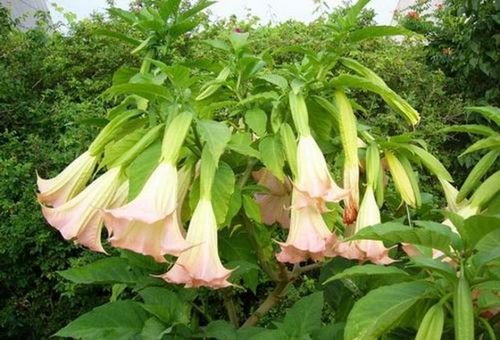
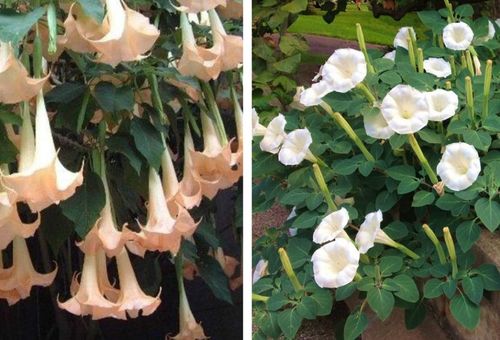
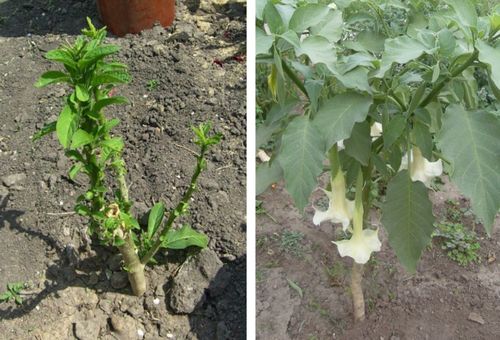

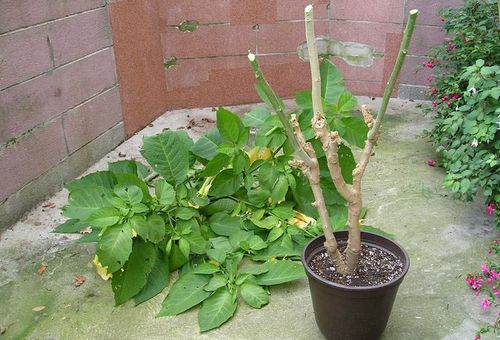
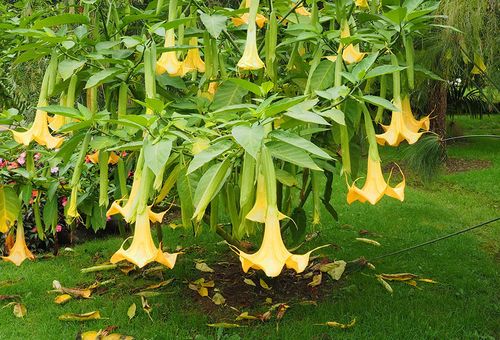
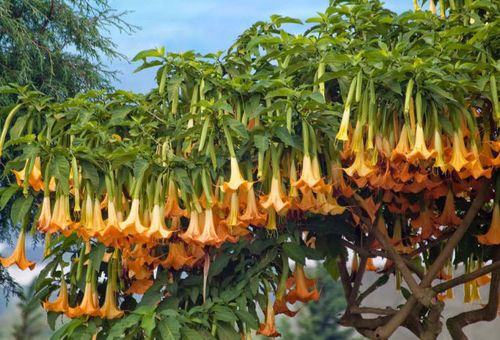
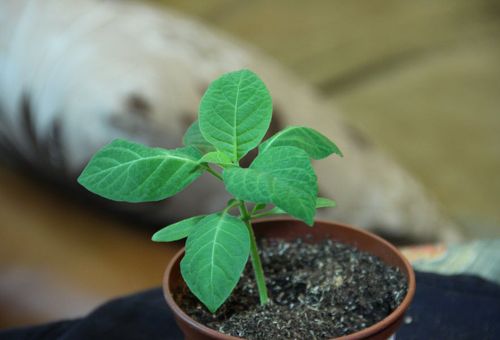
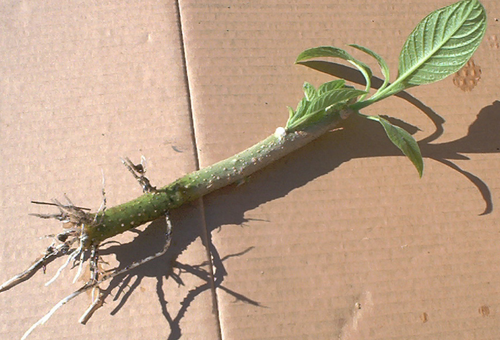
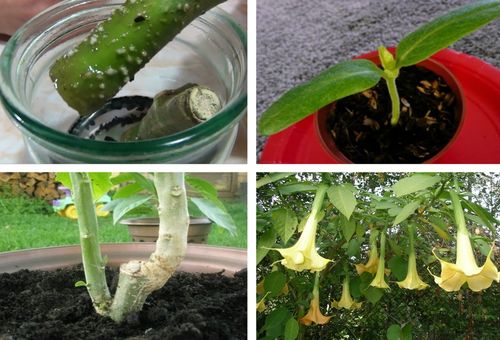


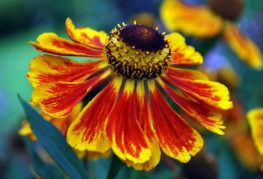
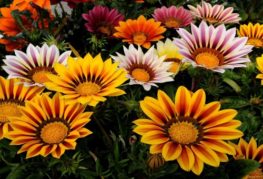

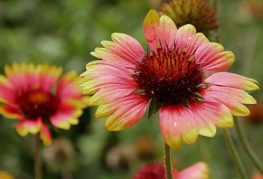
How long does it take from planting a cutting to flowering brugmansia?